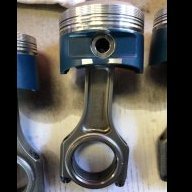GTR R33 RWD-AWD TOGGLE ??
Announcements
-
Similar Content
-
Latest Posts
-
He's right ~ there is no 'magic' with stuff like this ... it is more likely that in the process of looking for the short, the loom/wire 'incidentally' got moved in the process, thus removing the short ~ now, that maybe a wire (in a loom) rubbing against the edge of some grounded metal, that's worn through the insulation, causing the (now intermittent) short to ground. If one wire in a loom has been damaged in this fashion, it's reasonable to presume that other wires beside it may have also be damaged, and now exposed...you can bet the green crusty copper corrosion will start... ...that'd be a pisser, Murphy's Law steps right in as GTS observes...but worse, something like that is easier to find when shorted...ie; unplug bulb and fuse, and put multimeter in continuity mode so you get constant beep, and carefully poke about hoping to find if some movemet of the harness stop the beeping.... ...it's still all a bit Arnie tho' ..It'll be back... 😃
-
Yeah, but knowledge of one wire's insulation worn through to short on earth implies the possibility of other wires doing the same. I had my power steering die, because the wire that runs to the solenoid valve on the rack runs in the same loom as the power wire for the O2 sensor. And when the O2 sensor/wire did something stupid and burnt part of that loom to death, the only indication was the shit(ter) fuel economy and the heavy steering. It took deep excavation of the looms in the bay to find the problem. Not wear through in that case, but similar shit.
-
Ah, I thought he'd wired it to one of the spare ECU inputs! Too long ago since I read that post, ha ha. I've been arguing with radiators, harmonic balancers, alternators and rust since reading it.
-
Correct. The ECU cannot read oil temp. (Well, I think it probably can in some situations. I did have the thought of potentially repinning the ECU when I was doing oil pressure). I am using this into the MPVI dongle, so that the MPVI dongle can read oil temperature. It is attached to a VDO gauge which is obviously calibrated to whatever curve the sender actually is using. This would be easy if I could setup a table of voltage to temperature like many sensors, but it appears I cannot do this and can only setup the transform rule which appears to be Input (voltage) x Multiplier, and add an offset. This to me means it MUST be linear. So it may be a complete waste of time wiring this into the ECU. The idea was that the MPVI3 has standalone logging. I wanted to use this instead of a laptop with serial cable (for wideband) for long datalogs. Given the wideband also has electric interference, I may never trust this either in a world where the serial wideband and the analog output wideband do not agree. Last time I did a trace I could see the two wideband traces follow each other, but one was a little leaner than the other. I plan on playing with voltage offsets and actually driving the thing to see how close they correlate. If they never correlate... then, well, maybe I'll never use either. Ideally I'd like to have the Analog wideband read ever so slightly leaner than the serial one, because the serial one is 'correct'. Tuning the car to be ever so slightly too-rich would be the aim. Not needing to have a laptop flying around in the footwell connected with cables is... an advantage. About the only one from the forced upgrade to MPVI3.
-
Hopefully not, since he knows the fuses work ha ha ha
-






Recommended Posts
Create an account or sign in to comment
You need to be a member in order to leave a comment
Create an account
Sign up for a new account in our community. It's easy!
Register a new accountSign in
Already have an account? Sign in here.
Sign In Now